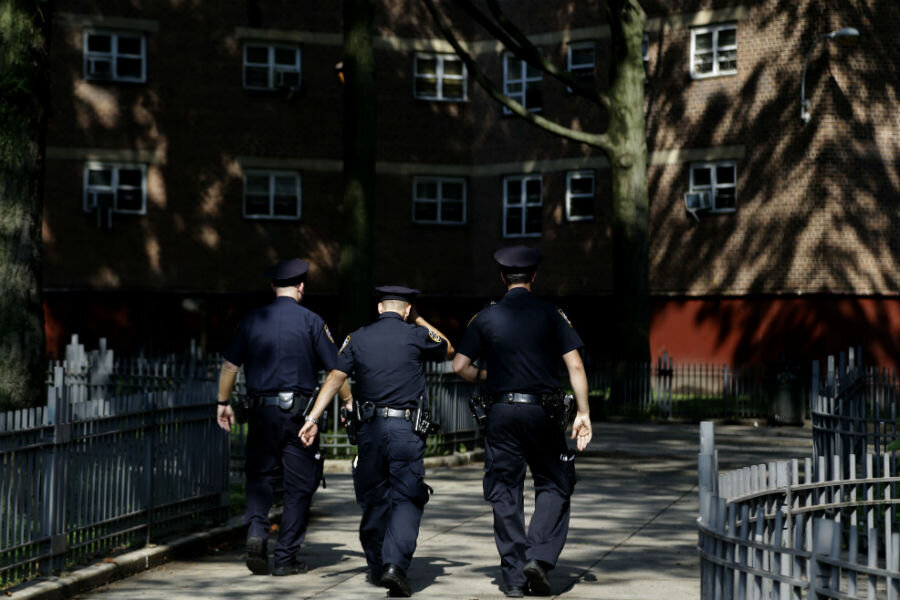Did a 2013 court ruling really spell the end of stop and frisk?
In an elliptical answer to a question on racial tensions during Monday night’s presidential debate, Republican presidential candidate Donald Trump praised the utility of “stop-and-frisk” policing programs in protecting what he described as inner cities “decimated” by crime.
“In a place like Chicago, where thousands of people have been killed, thousands over the last number of years…We have to bring back law and order,” Trump told an audience of an estimated 84 million viewers, according to a transcript from the Washington Post. “Now, whether or not in a place like Chicago you do stop and frisk, which worked very well, Mayor Giuliani is here, worked very well in New York. It brought the crime rate way down. But you take the gun away from criminals that shouldn't be having it.”
In fact, no consensus exists among criminologists as to whether the New York Police Department’s Stop, Question and Frisk (SQF) program, or others like it in other major American cities, was the reason why crime rates fell precipitously throughout the 1990s and 2000s – although a federal judge did rule in 2013 that the program was unconstitutional, being a form of “indirect racial profiling,” in what has become a landmark case in debates over policing.
The origins of New York’s program, however, may underscore the importance of social science in devising newer, better solutions to problems of crime and policing – as well as the utility of pressure from the public and civil-liberties advocates who demand fixes to situations that seem mired in paradox.
As Yale University law professor Tracey Meares wrote in a 2015 paper published in the Chicago Law Review, federal judge Shira Scheindlin’s ruling in 2013 did not deem stop-and-frisk unconstitutional as a tactic. Rather, it took issue with the NYPD’s use of them on a massive scale: 685,724 of them were carried out in 2011, the program’s peak.
“The tactic itself is not unconstitutional,” she writes in an email to The Christian Science Monitor. “The program that the NYPD used resulted in far too many unconstitutional stops.”
Under the Fourth Amendment of the US Constitution, which guards against unreasonable searches and seizures, police need “probable cause” to stop and search someone. That is, they need good reason to believe a person has committed or is about to commit a crime.
As the Monitor has reported previously:
But a 1968 US Supreme Court decision, Terry v. Ohio, lowered that benchmark by allowing law enforcement to stop and search people in a public place if the officer “reasonably suspects” that someone is about to commit a crime, and can "articulate" a valid reason for the stop and frisk. Reasonable suspicion alone is not grounds for arrest, as probable cause is, but incriminating evidence found during a stop and frisk may be grounds for arrest.
The problem is that “reasonable suspicion” is more vague than “probable cause,” leading some opponents to argue that law enforcement officers use a person's race to determine reasonable suspicion, and therefore, perform stop and frisks.
Since 1969, the Supreme Court has expanded the rights of police to stop and search citizens in a series of decisions.
Judge Scheindlin’s 2013 opinion was based largely on a report by Columbia law school criminologist Jeffrey Fagan, who found that after controlling for crime reports, poverty, police patrols, and other factors, the NYPD was still disproportionately targeting areas with a higher concentration of minority residents.
The NYPD’s program, as well as that of other large cities, has its origins in a 1995 study in Kansas City directed by Lawrence Sherman, then a professor at the University of Maryland-College Park. When police officers in that city deployed three strategies including stop and frisk in an attempt to increase gun seizures in a single district, gun seizures went up 65 percent, much higher than the rate of a control district. Meanwhile, gun crime fell nearly 50 percent in the test district, while the control district saw almost no change.
“Scores of cities rushed to follow the Kansas City model, including, perhaps most famously, New York City,” wrote Professor Meares at Yale.
On Monday evening, Mr. Holt, the moderator, pointed out to Mr. Trump that the strategy had been ruled unconstitutional. Trump responded with a different account of a case that has become a landmark in debates over policing.
“It went before a judge, who was a very against-police judge,” he said. “It was taken away from her. And our mayor, our new mayor, refused to go forward with the case. They would have won an appeal. If you look at it, throughout the country, there are many places where it’s allowed.”
Michael White, a professor who directs Arizona State University’s PhD program in criminology and criminal justice, says that the candidate may have meant to refer to an appeals court’s later decision to remove the federal judge, Shira Scheindlin, from the case for violating her appearance of impartiality.
“But the bottom line is that the city and the police commissioner both recognized the problem,” says Dr. White, adding that the NYPD has cut back precipitously on the use of stop and frisk. “I don’t think it’s fair to say that the program wasn’t unconstitutional. We’ve got a federal judge and court ruling that that was so, and the city accepted that and moved away from stop and frisk.”
Meanwhile, he says, places like San Diego, where authorities in the 1990s implemented community-policing measures similar to those that have emerged as a popular alternative, saw a parallel drop in crime, without the accompanying damage between police and minority communities.
“What’s clear now is that the collateral damage caused by the stop and frisk program far exceeded any potential benefits,” he tells the Monitor.








